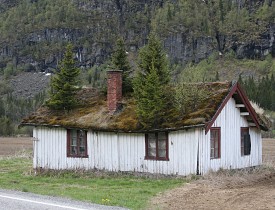Your Roof is Moldy. Now What?
 Scientists may think mold is great, but the rest of us have a hard time not resenting it. The stuff grows everywhere, from the cheese in the fridge to the bathroom ceiling to the very skeleton of the house. And yes, it can even grow on your roof. The good news is that moldy roofing shingles, unlike old cheese, don't need to be thrown out. Here's how to get rid of roof mold and keep it from coming back.
Scientists may think mold is great, but the rest of us have a hard time not resenting it. The stuff grows everywhere, from the cheese in the fridge to the bathroom ceiling to the very skeleton of the house. And yes, it can even grow on your roof. The good news is that moldy roofing shingles, unlike old cheese, don't need to be thrown out. Here's how to get rid of roof mold and keep it from coming back.
Roof Mold by Any Other Name
A lot of the dark streaky stuff found on roofs in wet climates like Seattle is actually algae. You probably don't care to know the difference, and neither does the roofing industry, as most cleaning solutions and other products for roofs are targeted at mold, mildew, lichen, moss, slime, or algae … it all works the same. But for the record, algae commonly feeds on the limestone powder in asphalt shingles, while mold often thrives on plant and other organic matter that's fallen onto your roof. You can't do anything to prevent algae and mold spores from flying through the air and landing on your roof, but you can help prevent mold growth by keeping the shingles free of organic matter.
Get Rid of Mold and Algae on Your Roof
The old standard method for cleaning algae and mold stains from asphalt shingles is to spray on a solution of chlorine bleach and water. Some people add TSP (trisodium phosphate) for extra cleaning power. You let the solution sit for about 5 minutes, or so. Then rinse it off with garden hose, not a pressure washer, which can damage your roofing.
However, I'm not recommending bleach for a few reasons: It's toxic to plants (and most other living things), and it can damage shingles if it's left on too long or isn't completely rinsed off. You can protect your plants from bleach spray, but then you have the rinse water pouring down your gutters into your yard, etc. Not worth the trouble.
A Better Way to Clean Your Roof
A better solution is to buy a commercial roof-cleaning product, such as Spray and Forget.
As a protective measure, you still have to spray any surrounding foliage with water before and after applying the cleaner, but there's no rinsing required, and many of these products offer extended protection against future algae and mold growth. The best (and cheapest) way to apply it is with a garden sprayer from the roof, but there also are concentrated versions you can hook up to a garden hose to apply from the ground.
One drawback of these cleaning solutions is that, unlike bleach, they take a little time to get rid of the staining, sometimes several weeks or months.
Prevent Roof Mold in Future
There are a few simple ways to keep mold and algae from returning to your newly washed roof. The simplest is to apply a cleaning or treatment product formulated for long-term protection against algae and mold growth. There's also the longstanding preventative measure of installing zinc or copper strips near the ridge line of the affected roof planes. Both metals contain minerals that naturally inhibit algae and mold. You simply slip the strips under the shingles, leaving the metal partially exposed, and nail the strips in place. When it rains, the runoff water carries minerals off of the metal and washes them down the roof. (If your roof has copper flashing around the chimney, you might notice that there's little or no algae growth on the shingles directly below the flashing.)
More Ways to Keep Your Roof Mold-Free
As mentioned earlier, regular cleaning to remove leaves, twigs and other organic material helps to keep a roof mold-free. Finally, for a really long-term, low-maintenance solution, you can specify algae-fighting shingles when it's time to hire a contractor to replace your old roof. These are made with copper-clad granules (blended in with the regular mineral granules) on asphalt shingles. The special granules naturally inhibit algae growth by the same process as the zinc and copper strips.
This article was updated November 12, 2017.
Looking for a Pro? Call us (866) 441-6648

Roofing Average Costs
Roofers Experiences

Siding And Roof Replacement By The Same Contractor

Cement Tile Roof Repair Took Some Detective Work



